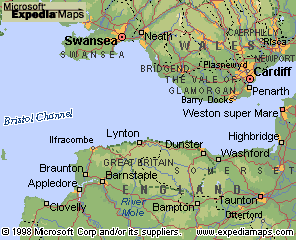Posted on 04/30/2007 4:14:31 PM PDT by blam
Source: University of Chicago Press Journals
Date: April 30, 2007
Was Bristol Channel Hit By A Tsunami?
Science Daily — On the occasion of the 400th anniversary of Britain's largest natural disaster, the author of Tsunami: The Underrated Hazard, reveals strong new evidence that the Bristol Channel was devastated by a tsunami on January 30, 1607. On that day, historical accounts describe a storm in the Bristol Channel, flooding more then 500 km2 of lowland and killing 2,000 people.
"Despite the recent Indian Ocean tsunami of 2004, tsunamis along most coastlines are currently viewed as an underrated hazard," write Edward A. Bryant (University of Wollongong, New South Wales, Australia) and Simon K. Haslett (Bath Spa University, UK). "But an examination of the prehistoric record along many of these coasts gives conclusive evidence of depositional and erosional impact of tsunamis, in some cases of immense proportions."
They continue: "Our purpose here is only to present field evidence showing that Bristol Channel in the United Kingdom has been subject to tsunamis."
In a paper appearing in the May issue of The Journal of Geology, the researchers explore the area affected by the 1607 flood, extending from Barnstaple (Devon) and the Carmarthenshire coast to the head of the Severn Estuary at Gloucester. They use an established catalog of geomorphic features indicating the presence of tsunamis in coastal landscapes, such as sand layers, overlapping boulder deposits, cavitation, bedrock sculpturing, and landscape erosion.
Of these features, bedrock sculpturing and landscape erosion require the greatest water depth and are least subject to the contention that they may be the result of storm surges. Bedrock sculpturing by a tsunami requires a water depth of 10-60 meters (approximately 32-196 feet), while landscape erosion has been found only under the most extreme conditions.
The researchers found evidence in four locales of the sort of bedrock sculpturing linked elsewhere to tsunamis. In Infracombe on the northwest Exmoor coast, they found juxtaposed cliff-types -- cuestas and scarps -- and muschelbruche (scallop-shaped depressions) that reveal substantial unidirectional water flow from the west.
In Ogmore, in southeast Wales, the researchers found both rock and boulder "dumps" and shallow vortex pools with forms that indicate their formation was rapid, occurring in a matter of minutes. The researchers also found evidence of coastal erosion at Sully Island and Ball Rock, where the Bristol Channel decreases in width by 30 percent. According to the researchers, any tsunami traveling up the channel would have been constricted at this point and forced to increase in height dramatically.
"This article adds to recent evidence juxtaposing the geological and historic records," write Bryant and Haslett. "The fact that the signatures of tsunami are found in Bristol Channel up to the more sheltered Severn Estuary is surprising because the northwest European coast in general is not considered tsunami prone."
According to the authors, likely triggers for a tsunami in this region are an earthquake, an underwater landslide, or a combination of both. They point out that an active fault zone lies off the coast of Ireland and, indeed, second-hand reports mention a tremor felt on the morning of January 30, 1607.
Reference: Edward A. Bryant and Simon K. Haslett, "Catastrophic Wave Erosion, Bristol Channel, United Kingson: Impact of Tsunami?" The Journal of Geology: 115, p. 253-269.
Note: This story has been adapted from a news release issued by University of Chicago Press Journals.

There's some evidence against their new theory. I would expect a seagoing people to know a storm if they saw one.
The death toll would have been lower, but they were holding the first annual Bristol Fashion show.
Yes, it’s true, I have poor impulse control.
 |
||
| · join · view topics · view or post blog · bookmark · post new topic · | ||
Please FREEPMAIL me if you want on or off the
"Gods, Graves, Glyphs" PING list or GGG weekly digest
-- Archaeology/Anthropology/Ancient Cultures/Artifacts/Antiquities, etc.
Gods, Graves, Glyphs (alpha order)
There is no reason that a storm and a earthquake/tsunami cannot happen simultaneously. People living at a time when there are no seismographs and no understanding that the two are separate phenomena would see the storm as really, really bad weather.
http://en.wikipedia.org/wiki/Megatsunami
That is a wall of water 400 feet higher then the Hoover dam.
Jamestown?
Yes, I knew that. I saw it on one of the documentary channels. Amazing.
Most interesting.
Not really. It's cost vs. probability.
I think there’s another topic about this, but anyway, this one must be older:
Do you want to hear a real earthquake story? Here you go.....
Source: NOAA.gov
Published: ?
Posted on 03/01/2001 20:08:41 PST by Trailer Trash
http://www.freerepublic.com/forum/a3a9f1cc964a4.htm
That has much more detail.
thank you
|
|
|||
Gods |
Just updating the GGG info, not sending a general distribution. |
||
|
· Mirabilis · Texas AM Anthropology News · Yahoo Anthro & Archaeo · · History or Science & Nature Podcasts · Excerpt, or Link only? · cgk's list of ping lists · |
|||
Disclaimer: Opinions posted on Free Republic are those of the individual posters and do not necessarily represent the opinion of Free Republic or its management. All materials posted herein are protected by copyright law and the exemption for fair use of copyrighted works.